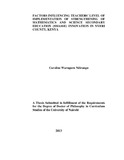| dc.description.abstract | The Kenya government in partnership with the Japanese government took the
initiative to address the poor performance of learners in science subjects at
secondary level by building the capacity of teachers. Strengthening of
Mathematics and Science Secondary Education (SMASSE) in-service training
has been ongoing since 2004. The in-service training intervention is
constructivist, its emphasis is on Activity-focused methods, Student-Centered
activities, Experimenting and Improvisation (ASEI) through the Plan, Do, See,
and Improve (PDSI) approach in science classrooms, referred to as ASEIPDSI
classroom practices innovation. Despite the in-service training the
performance of students in these subjects has remained low. The change
facilitators very often presume that once an innovation has been adopted and
the initial training has been completed, the intended users will put it into
practice. Implementation of an innovation is seldom so simple without
support. The main objectives of the study were to establish the teachers’ level
of implementation of ASEI-PDSI classroom practices, identify the Stages of
Concerns of both the head teachers and the teachers and their attitude towards
the implementation of this innovation. Study adapted a survey design with a
sample of 68 head teachers, 147 science teachers and 10 SMASSE district
trainers. Data was collected by the use of questionnaires, observation
schedules and unstructured interviews. Data analysis was both descriptive and
inferential. Chi-square was used to test the null hypotheses. The study
established that the teachers’ implementation of ASEI-PDSI classroom
practices was partial, less than 5% were implementing fully. The main
concerns of the implementers fell in three main categories; self, task and
impact. Majority of head teachers and teachers had self-concerns less than
20% had task and impact concerns. The findings indicated that implementers
who had self-concerns were not implementing the ASEI-PDSI practices and
those with impact concerns were implementing the innovation. Two of the null
hypotheses were neither rejected nor accepted while three were rejected and
the alternative hypotheses accepted. There was a significant relationship
between the teachers’ attitude and the level of implementation. However there
was dissonance in the teachers’ positive attitude and their level of ASEI-PDSI
classroom practices level of implementation, which was partial. The head
teachers’ attitude towards the ASEI-PDSI classroom practices was negative
meaning the teachers’ lacked support from the heads during implementation.
Based on those findings, the researcher concluded that there was a significant
relationship in the teachers’’ attitude and their level of implementation of
ASEI-PDSI classroom practices. Further, there was also a significant but
negative correlation between the head teachers’ attitude, the KCSE science
performance and the level of implementation. This study overall conclusion
was that the teachers are the major determinants of the implementation of the
ASEI-PDSI innovation. The study recommended that the facilitators of
change, that is, the head teachers and the innovators of ASEI-PDSI classroom
practices need to urgently address the self and task concerns of the teachers so
that they can start implementing the ASEI-PDSI classroom practices fully.
xviii
Secondly, there is need for head teachers to strengthen the supervision of
ASEI/PDSI classroom practices implementation and further training should be
provided for effective management of teachers after an in-service program.
The study recommended that further studies could be carried out to investigate
the teachers’ level of implementation in other counties. | |

